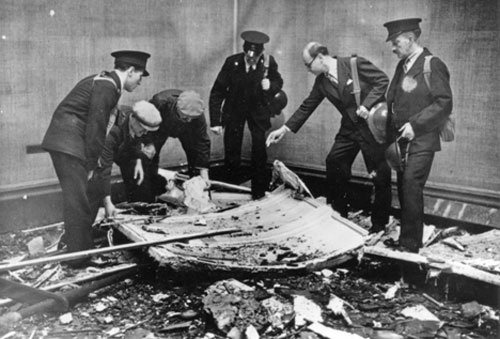Simon Starling
Phantom Ride
12 Mar - 20 Oct 2013

Tate Director John Rothenstein with Tate staff surveying the damage caused by a bomb which hit the Gallery on 16 September 1940
The Tate Britain Commission invites an artist to develop a new work in response to the Tate collection, highlighting the continuum of visual and intellectual ideas between historic and contemporary art.
For 2013, Simon Starling invites you to take a ‘rollercoaster ride on invisible rails’ through histories and memories of Tate Britain’s famous Duveen galleries with Phantom Ride.
Collapsing time and space, cutting back and forth on a looping trajectory, Simon Starling redoubles the space of the galleries with huge projection screens and reveals significant artworks and events that have previously animated the space like ghostly apparitions. Float weightlessly over the rubble of the destructive bomb-blast that ruptured the space in 1940, confront an up-turned Jaguar jet fighter, and greet iconic paintings that float ethereally mid air.
The phantom ride was a genre of film popular in the very early days of cinema. A camera was fixed to a moving vehicle to simulate a journey for an immobile cinema audience. They sat pinned to their seats, white-knuckled for fear they might de-rail on the next precipitous bend. The train tracks or the road anticipated the trajectory of the ‘phantom’ vehicle. Here though, the way has vanished. The highly precise and repeatable movements of the huge robotic arm on the similarly track-bound ‘motion control camera’ used to make this film facilitate a rollercoaster ride on invisible rails. The film’s soundtrack is the only remaining evidence of the camera’s week-long presence in the Duveens – the audible contractions and expansions, the ascents, descents and contortions, of a very real machine.
Simon Starling
The Duveen Sculpture Galleries opened to the public in 1937. Stretching over 300 feet, the two long galleries with high, barrel-vaulted ceilings were the first public galleries in England designed specifically for the display of sculpture. They were founded by Sir Joseph Duveen and designed by the architects Romanie-Walker and Gilbert Jenkins.
Using video, film, photography, slide projection and sculpture, Simon Starling reworks existing objects and architectural spaces, adding layers to their histories to create compelling poetic narratives. His works often use historical or geological research as a point of departure, and explore the origins of materials and the processes which transform them into functional objects.
Born in Epsom in 1967, Starling studied photography and art at Maidstone College of Art, Trent Polytechnic Nottingham and Glasgow School of Art. Since his first solo exhibition at the Showroom in London in 1995, his work has been widely exhibited in the UK and elsewhere. Recent exhibitions include Simon Starling: Recent History at Tate St Ives in 2011, Project for a Masquerade at the Museum of Contemporary Art, Hiroshima in 2011, THEREHERETHENTHERE (Works 1997–2009) at the Musée d’ArtContemporain du Val-de-Marne, Paris in2009 and Cuttings (Supplement) at ThePower Plant, Toronto in 2008. He wasawarded the Turner Prize in 2005 for Shedboatshed.
For 2013, Simon Starling invites you to take a ‘rollercoaster ride on invisible rails’ through histories and memories of Tate Britain’s famous Duveen galleries with Phantom Ride.
Collapsing time and space, cutting back and forth on a looping trajectory, Simon Starling redoubles the space of the galleries with huge projection screens and reveals significant artworks and events that have previously animated the space like ghostly apparitions. Float weightlessly over the rubble of the destructive bomb-blast that ruptured the space in 1940, confront an up-turned Jaguar jet fighter, and greet iconic paintings that float ethereally mid air.
The phantom ride was a genre of film popular in the very early days of cinema. A camera was fixed to a moving vehicle to simulate a journey for an immobile cinema audience. They sat pinned to their seats, white-knuckled for fear they might de-rail on the next precipitous bend. The train tracks or the road anticipated the trajectory of the ‘phantom’ vehicle. Here though, the way has vanished. The highly precise and repeatable movements of the huge robotic arm on the similarly track-bound ‘motion control camera’ used to make this film facilitate a rollercoaster ride on invisible rails. The film’s soundtrack is the only remaining evidence of the camera’s week-long presence in the Duveens – the audible contractions and expansions, the ascents, descents and contortions, of a very real machine.
Simon Starling
The Duveen Sculpture Galleries opened to the public in 1937. Stretching over 300 feet, the two long galleries with high, barrel-vaulted ceilings were the first public galleries in England designed specifically for the display of sculpture. They were founded by Sir Joseph Duveen and designed by the architects Romanie-Walker and Gilbert Jenkins.
Using video, film, photography, slide projection and sculpture, Simon Starling reworks existing objects and architectural spaces, adding layers to their histories to create compelling poetic narratives. His works often use historical or geological research as a point of departure, and explore the origins of materials and the processes which transform them into functional objects.
Born in Epsom in 1967, Starling studied photography and art at Maidstone College of Art, Trent Polytechnic Nottingham and Glasgow School of Art. Since his first solo exhibition at the Showroom in London in 1995, his work has been widely exhibited in the UK and elsewhere. Recent exhibitions include Simon Starling: Recent History at Tate St Ives in 2011, Project for a Masquerade at the Museum of Contemporary Art, Hiroshima in 2011, THEREHERETHENTHERE (Works 1997–2009) at the Musée d’ArtContemporain du Val-de-Marne, Paris in2009 and Cuttings (Supplement) at ThePower Plant, Toronto in 2008. He wasawarded the Turner Prize in 2005 for Shedboatshed.
